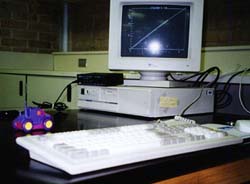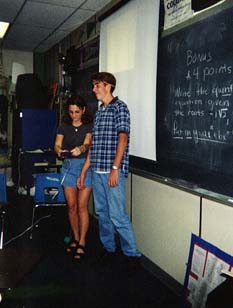



Interested in writing a story
or nominating a friend? Yes
Translate this story into Spanish? Yes
|
Velocity, acceleration, and students in motion
With CBLs, physics students can become the body in motion in their own experiments with acceleration and velocity. By Nancy J. Easterly |
|
To attempt to change their thinking, I have thrown a ball in the classroom, painted visual pictures of the students driving down the highway, played videodisk demonstrations, discussed amusement park rides, had the students describe moving situations to me, yet the students tend to make the same conceptual understanding mistakes over and over again. |
|||
|
To try to overcome both of these problems, last year the physics and precalculus teachers combined efforts and wrote a grant proposal to purchase a class set of calculator-based laboratory units (CBL's) with additional probes and an overhead projection unit. These instruments are fully portable and attach to a Texas Instruments-82/83/85 graphing calculator. The data can be downloaded to computers in the physics computer lab, and, in the future, to the computers in the precalculus classrooms. We are working now on ways to use the software collaboratively to actively reinforce each other's course. |
|
|
|||
 Marilyn demonstrates the CBL with motion sensors at a teacher workshop. |
"We need to talk. I gave a quiz today and the majority of the students enrolled in both physics and precalculus missed a graphing question, while those enrolled only in precalculus got the question right. What are you guys teaching?" Earlier in the week, her students had performed an experiment obtaining the cooling curve for water as an example of a decay curve. The experiment was a great success--the students were excited to discover that this type of graph had real world relevance. The data obtained from the temperature probe and CBL was good and fit the characteristics of the curve perfectly. When the students left her room, she thought that they had mastered this concept. Unfortunately, the overall shape of the decay curve that the math classes obtained is similar to the shape of the hyperbola that was illustrated in my physics classes. By not making precise observations between the differences of these two curves during the physics graphing lab, the students made a quick evaluation based on the general shape without considering all of the characteristics. Teachers of both classes are now aware of this visual misconception. A new emphasis will be placed on observational skills as well as pointing out the similarities and differences between these two graphs by the teachers of both subjects. Technology not only created a problem, but helped the instructors solve the problem. If it had not been for the ability of the math teacher to recognize that only physics students were incorrectly identifying the curves, this misunderstanding would have been missed by the teachers of both subjects. |
|
"Look, there are toys in the physics lab. Hey, man, cool!" Toys to help teach physics? You bet! Playing with toy cars relieves the threatening feeling of the hard-core physics and mathematics, allowing the student to begin to see the relationships we have discussed in class. It also helps them realize that physics is everywhere. This physics computer laboratory activity involves hooking battery-operated cars to a smart pulley (computer-based probeware) to analyze the characteristics of constant velocity. The students print out graphs of displacement vs time, velocity vs time, and acceleration vs time. Slopes and areas are calculated and compared to the values read from the data tables. The students also study accelerated motion in the same way and compare the graphs between the two situations. The students really enjoy this lab, because they are beginning to see the relevance of physics to their lives. |
|||
 Using toy cars lessens the intimidation of hard-core physics. |
To begin this activity, a student stands in front of a motion sensor, connected to the CBL and graphing calculator. A displacement-time graph is displayed on the calculator screen. At the signal, the student standing in front of the motion detector begins to move, trying to match the graph. The feedback to the participant and observers is immediate. The motion detector does not wait for the students to think about what they are doing. If the student hesitates, the match is incorrect. Others in the group are allowed to coach or help. The precalculus classes experimented on the very first day of school in August. Since no introductions were provided, the students completed the exercise by trial-and-error. The classes roared and cheered and ahhed as various students met with success and failure. Some students wanted to try again to do better. Everyone was a chairside coach. One result of this activity was total classroom involvement as students watch their friends. This event also piqued the interest of most students. It was an unqualified success. |
|
"We've seen this before, why do we have to do this again? Do we h-a-a-ve to do this?" With the carrot of free time upon completion, and by pitting some of the more competitive students against each other, the students were quickly persuaded to repeat the activity. The competition in some groups was intense. "Look, James, you didn't even start out moving in the right direction . . . the line is going up instead of down! Get out of the way, I can do better."
Some groups planned, others didn't. After observing the graph to
be duplicated,
one group of planners decided, "Okay, now you have to walk slowly toward the
detector, stop for about 3 seconds and then go back faster to the starting point.
Have you got it? Now, try!" |
|||
 Two students using the CBL to understand motion. |
"Being part of the experiment instead of an observer allowed me to experience constant and accelerated motion." "I now know how the precalculus formulae relate to real situations." "I can't even walk down the hall, drive my car, or go anywhere without seeing the physics and mathematics involved." "You made what I thought was going to be another dull, dry science class exciting." |
|
|
|||
|